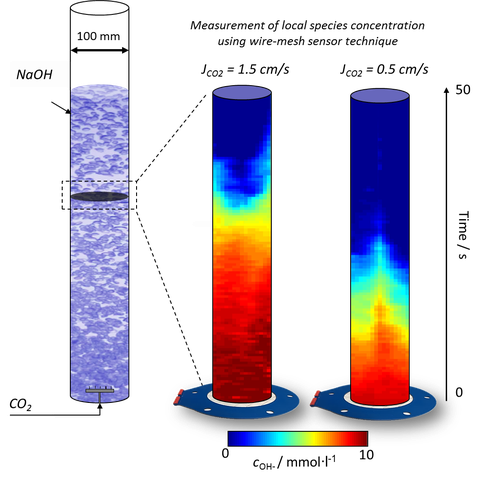DFG Priority Program SPP1740: The Influence of Local Transport Processes on Chemical Reactions in Bubble Flows
Sub-Project:
Experimental studies on the hydrodynamics, mass-transfer and reaction in bubble swarms with ultrafast X-ray tomography and local probes
Motivation:
For reactive processes bubble column reactors, which are mainly used in chemical industries, are operated in a gas dispersed two-phase flow. In such systems, a complex relation of hydrodynamics, mass transfer and reaction prevails which determines the reaction progress and thereby the yield and selectivity of the chemical processes. Simple reactor models are usually not able to describe these phenomena. Local parameters such as gas holdup, bubble size distribution and bubble induced turbulence become more important in systems with high gas density. Especially the influence of bubble induced turbulence on the structure of bubble swarms, the resulting mass transfer in the liquid phase and the associated distribution of the reactive species are so far insufficiently studied due to the lack of measurement techniques.
Objectives:
The aim of this project is the experimental investigation of hydrodynamics in a bubbly flow with a gas holdup > 10%. Using the ultrafast X-ray CT, the bubble swarm dynamics and flow structure is investigated. In addition, the influence of the bubble swarm dynamics on the mass transfer and mixing of chemical species in the liquid bulk is examined. Wire-mesh sensors and a fiber optical probe are utilized to measure local and cross-sectional concentrations of chemical species.
Methods and results:
From ultrafast X-ray CT data, characteristic parameters of the gas phase hydrodynamics are extracted (e.g. gas holdup, bubble size, structure of bubbles in a swarm). As a model reaction for mass transfer measurements, the chemical absorption of CO2 has been used. For the evaluation of mass transfer relevant parameters, the wire-mesh sensor has been applied in order to visualize local concentrations of the ionic species (see figure) and to quantitatively determine the consumption rate of OH- species.
In the second funding period, a model reaction provided and characterized by project partners from LMU München is used. Here, an FeII(ligand) solution reacts with nitrogen monoxide to a nitrosyl-iron complex, which in contrast to the NO-free complex shows a significant absorption band in the UV/VIS spectral range. Thus, a minimal invasive UV/VIS probe is used to determine the local species concentration in the wake of bubbles and bubble swarms. Based on these measurement data, the mixing of chemical species in the wake of single bubbles and within a bubble swarm is analyzed.
Publications:
R. Kipping , E. Schleicher, H. Kryk, U. Hampel
Characterization of a chemical reaction in a bubble column using Wire-Mesh Sensor and ultrafast X-ray CT
Proceedings 8th World Congress on Industrial Process Tomography (WCIPT8), 24.-26.09.2016, Brazil
R.Kipping, H. Kryk, E. Schleicher, M. Gustke, U. Hampel
Application of a Wire-Mesh Sensor for the Study of Chemical Species Conversion in a Bubble Column
Chem. Eng. Technol., 40 (2017): 1425–1433. doi:10.1002/ceat.201700005
R.Kipping, H. Kryk, U. Hampel
Experimental analysis of the gas phase dynamics in a lab scale bubble column operated with deionized water and NaOH solution under uniform bubbly flow conditions
Chem. Eng. Sci, 229 (2021): 116056. doi: 10.1016/j.ces.2020.116065

